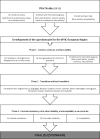WHO Standards-based questionnaire to measure health workers' perspective on the quality of care around the time of childbirth in the WHO European region: development and mixed-methods validation in six countries
- PMID: 35396296
- PMCID: PMC8995570
- DOI: 10.1136/bmjopen-2021-056753
WHO Standards-based questionnaire to measure health workers' perspective on the quality of care around the time of childbirth in the WHO European region: development and mixed-methods validation in six countries
Abstract
Objectives: Develop and validate a WHO Standards-based online questionnaire to measure the quality of maternal and newborn care (QMNC) around the time of childbirth from the health workers' perspective.
Design: Mixed-methods study.
Setting: Six countries of the WHO European Region.
Participants and methods: The questionnaire is based on lessons learnt in previous studies, and was developed in three sequential phases: (1) WHO Quality Measures were prioritised and content, construct and face validity were assessed through a Delphi involving a multidisciplinary board of experts from 11 countries of the WHO European Region; (2) translation/back translation of the English version was conducted following The Professional Society for Health Economics and Outcomes Research guidelines; (3) internal consistency, intrarater reliability and acceptability were assessed among 600 health workers in six countries.
Results: The questionnaire included 40 items based on WHO Standards Quality Measures, equally divided into four domains: provision of care, experience of care, availability of human and physical resources, organisational changes due to COVID-19; and its organised in six sections. It was translated/back translated in 12 languages: Bosnian, Croatian, French, German, Italian, Norwegian, Portuguese, Romanian, Russian, Slovenian, Spanish and Swedish. The Cronbach's alpha values were ≥0.70 for each questionnaire section where questions were hypothesised to be interrelated, indicating good internal consistence. Cohen K or Gwet's AC1 values were ≥0.60, suggesting good intrarater reliability, except for one question. Acceptability was good with only 1.70% of health workers requesting minimal changes in question wording.
Conclusions: Findings suggest that the questionnaire has good content, construct, face validity, internal consistency, intrarater reliability and acceptability in six countries of the WHO European Region. Future studies may further explore the questionnaire's use in other countries, and how to translate evidence generated by this tool into policies to improve the QMNC.
Trail registration number: NCT04847336.
Keywords: NEONATOLOGY; OBSTETRICS; Quality in health care.
© Author(s) (or their employer(s)) 2022. Re-use permitted under CC BY-NC. No commercial re-use. See rights and permissions. Published by BMJ.
Conflict of interest statement
Competing interests: None declared.
Figures
References
-
- World Health Organization . Every woman every child. Global strategy for women’s, children’s and adolescents health 2016–2030, 2016. Available: http://www.who.int/life-course/partners/global-strategy/global-strategy-... [Accessed 14 Apr 2021].
-
- United Nations . The Global Strategy for Women’s, Children’s and Adolescents’ Health (2016-2030). Every Woman Every Child, 2015. Available: https://www.who.int/life-course/partners/global-strategy/globalstrategyr... [Accessed 14 Apr 2021].
-
- The White Ribbon Alliance . Respectful maternity care charter: universal rights of women and newborns, 2021. Available: https://www.whiteribbonalliance.org/rmcresources/ [Accessed 14 Apr 2021].
Publication types
MeSH terms
Associated data
Grants and funding
LinkOut - more resources
Full Text Sources
Medical

